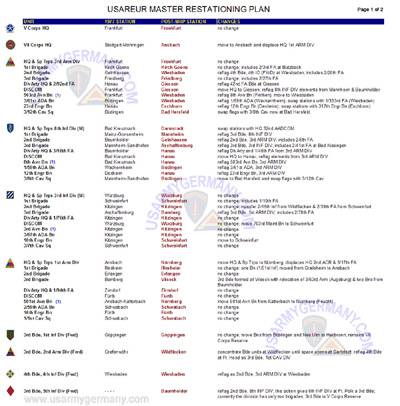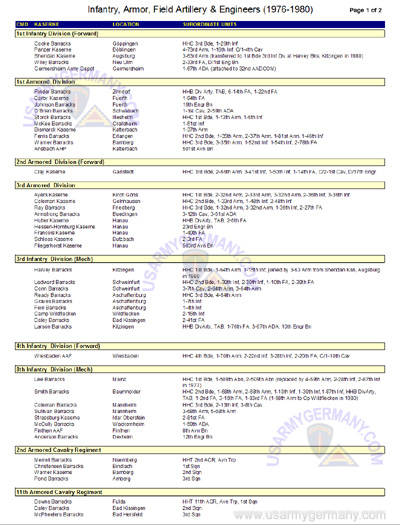If you do NOT see the Table of Contents frame to the left of this page, then
Click here to open 'USArmyGermany' frameset |
USAREUR Master Restationing Plan
United States Army, Europe
Looking for more information from military/civilian personnel assigned to or associated with the U.S. Army in Germany from 1945 to 1989. If you have any stories or thoughts on the subject, please contact me . .
|
|
|
|
| |
| FORWARD EDGE - Initial Plan |
|
(Source: Email from Karl Lowe, DCSOPS, HQ USAREUR, 1976-78) |
I returned to Germany in June 1976, assigned to DCSOPS as USAREUR's Doctrine Officer. Soon afterward, MG Gordon Duquemin became the DCSOPS. He and GEN Blanchard (then CINCUSAREUR) encouraged initiative so I took full advantage of the opportunity to try correcting something that had bothered me since I was a PFC at with the 1st Battalion 23rd Infantry (later 1-87th), a ROTOPLAN unit at Baumholder.
Following a "Welcoming" FTX near Worms, commanders traveled to their GDP positions by jeep. I was our company RTO, allowing me to participate. Of 14 operable M113s in our company at the beginning of the previous week's FTX, only 8 were able to complete the tactical road march from Baumholder to Worms. Troops doubled up in APCs and when that reached its limit, the rest were picked up by trucks. Imagine how worrisome that became when we drove nearly 3 times that far to Fulda to see our GDP area. I had no illusions that units positioned so far from their GDP positions would arrive in fighting shape.
13 years later, I was assinged to USAREUR DCSOPS as Operational Doctrine Officer, giving me a chance to participate in REFORGER 76, evaluating the 101st Air Assault Division's strengths and weaknesses for a war in Europe. The exercise, conducted in both corps areas that year, also gave me a chance to visit most major installations so I developed a mental picture of their layout. I became even more convinced of the time-distance-breakdown rate problem I'd observed more than a decade earlier. When I reported the exercise's doctrinal implications to MG Duquemin, I added some thoughts about repositioning units to better align with the GDP. He urged me to put those thoughts on paper.
|
|
|

Initial FORWARD EDGE Restationing Plan (Karl Lowe) |
|
I already knew where most divisional units were stationed because I'd studied the Army since I was a kid. What I didn't know was the capacity of posts (billets, admin facilities, motor pools, and family housing). I went through the most current unit phone directories, stationing lists, DCSPER strength reports, and installation engineer's layouts to give me an idea of where there might be excess capacity and where overcrowding existed. That told me which kasernes or communities could house a full brigade with its DS field artillery battalion, DS maintenance company, an MP platoon, and a Forward Area Signal Center Platoon. I then grouped brigade stations so that each division had two brigades as far forward as feasible and one farther back on a major road network leading to the division GDP area. The original draft plan took around 3 weeks to complete.
GEN Blanchard spent several hours with us poring over the plan. Convinced we were onto something important, he sent the draft to his Corps Commanders (LTG Starry and LTG Ott) who in turn staffed it with subordinate commands. Staffing at multiple levels took over a year and by then I had departed for Goeppingen as XO, 1st Battalion, 26th Infantry. Before sending the plan out for staffing, GEN Blanchard wanted it to have a catchy name. I suggested FORWARD EDGE to fit the intent.
The original plan maximized reflagging and minimized movement. Unfortunately, the corps got greedy and wanted the Germans to build a kaserne for the 2nd Bde 3rd Arm Div at Alsfeld and another that would have expanded Conn Bks, Schweinfurt to accommodate the 3rd Bde 3rd Inf Div. At the time, the Germans were building facilities for their "60-" and "70-series" home defense brigades and a US bill on top of that proved too high for the Bundestag. GEN Blanchard nevertheless secured the Army Staff's support for implementation and was prepared to nix the corps' construction requests but the Army was also building new facilities for the 5th, 7th, and 24th Inf Divs in the US and buying a wide range of new equipment and those took funding priority.
When I left Heidelberg in May 1978, MAJ Bill Pattison took over the project, renaming it the Master Restationing Plan (MRP). To the extent possible, he accommodated corps' and 32nd AADCOM's desires but individual preferences and unit loyalties were shifting the plan's emphasis from reflagging to movement, raising the cost beyond reach. I returned to Heidelberg on an extension in June 1979 as a member of the CINC's personal staff but played no further role in the MRP in my new capacity. Ultimately, only two battalions were moved (3-63rd Armor from Augsburg to Kitzingen and 1-68 Armor from Baumholder to Wildflecken), a sad end to a promising start. |
|
|

USAREUR Combat Arms Troop List, 1976-80 (Karl Lowe)
|
| |
| Webmaster note: If you were involved in subsequent MRP planning efforts at HQ USAREUR or Corps level, we would like to hear from you (email). |
|
|
| |
| USAREUR Master Restationing Plan (MRP) |
| |
(Source: DoD Annual Report to Congress, Fiscal Year 1984, Page 186) |
| The Army has a plan for relocating three brigades in Germany to U.S.-controlled land close to the eastern border of the Federal Republic of Germany. This plan, called the Master Restationing Plan, or MRP, is not a NATO program, but is an important part of our effort to strengthen the defense of Europe. The MRP supports force modernization, increased deterrence, and war-fighting capabilities, and would improve living and working conditions for American soldiers and their families.
In March 1982, senior-level delegations from the U.S. and Germany met to discuss the mutual benefits inherent in the MRP. As a result of this meeting, a working group was tasked to identify problems that could result from implementing the MRP. They reached agreement on the technical and administrative aspects of the plan, but not on how the plan is to be funded. During 1983, we will continue to hold MRP discussions with the Germans aimed at developing cost-sharing plans acceptable to both countries. |
|
| |
| (Source: GAO Report: U.S.-NATO Burden Sharing. Allies' Contributions to Common Defense During the 1980s, Oct 1990) |
| A major program in U.S. Army, Europe, during the 1980s resulted from studies conducted in the mid-1970s to resolve stationing problems.
This program, subsequently titled the Master Restationing Plan, envisioned correcting the malpositioning of U.S. troops in West Germany to (1) achieve a more effective forward defense and (2) remove these forces from inadequate facilities and urban areas where they could not maintain military preparedness without significantly inconveniencing the German people. The plan ultimately envisioned divesting U.S. Army, Europe, commanders of all except mission-related responsibilities for training and combat readiness.
Under the plan, the United States sought German funding for the construction of facilities for 28 battalions on three U.S.-controlled locations. The plan stalled, however, primarily because of congressional expressions that West Germany share the estimated construction costs in excess of $1.2 billion. West Germany was willing to provide real estate and pay for some infrastructure but insisted that construction of military facilities be a U.S. responsibility.
According to the State Department, although the Germans were positive about the plan’s concept, overall they viewed repositioning as a massive and politically sensitive issue whose implementation would present financial and environmental difficulties. According to DOD officials, the United States was able to correct some of the original malpositioning concerns by funding limited Master Restationing Plan-related station changes and constructing some facilities itself.
The United States also sought to obtain base operation and maintenance support through contracts with a German government agency or commercial organization on a completely reimbursable basis. By relieving U.S. forces of base support obligations in peacetime, U.S. Army, Europe, could concentrate solely on its primary mission of combat readiness. Although in the 1970s U.S. forces had been successful in obtaining contracts for base support at two U.S. facilities, West Germany showed no further interest in expanding the concept. In addition, the German government expressed concern that the provision of base support by a German agency would considerably increase the size of its bureaucracy.
In addition, U.S. forces have sought German government financing for modifications to U.S.-controlled facilities so that they would conform to German environmental pollution abatement standards. Although the United States recognizes its responsibility to ensure that it complies with these standards, it considers pollution abatement at host nation-owned, U.S.-operated facilities to be a host nation responsibility. Moreover, most West German pollution abatement standards have resulted from legislation enacted after these facilities were originally placed at U.S. forces’ disposal. Although West Germany has not provided funds to help U.S. forces meet these standards, U.S. forces have attempted to comply to the extent possible by, for example, designing all new con struction to meet German environmental standards. |
|
|
| |
Related Link
|
| |
|


